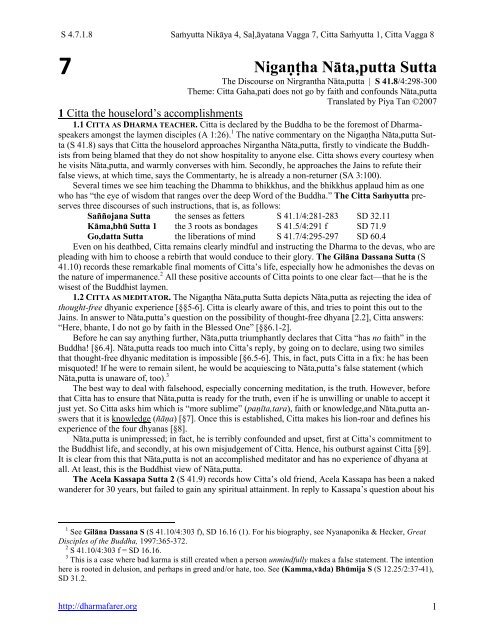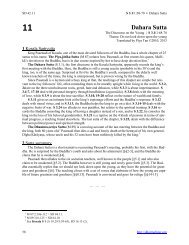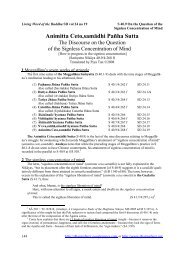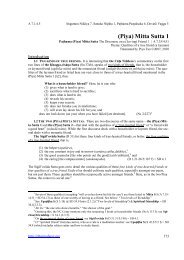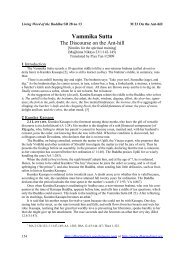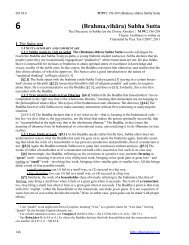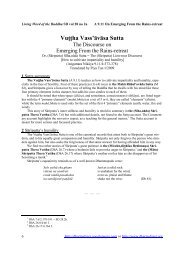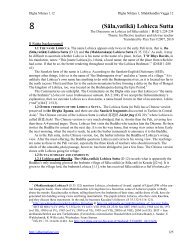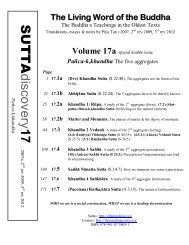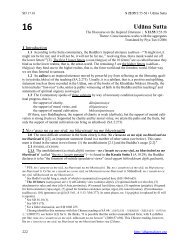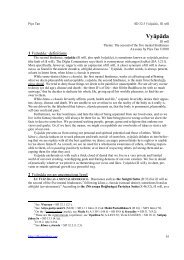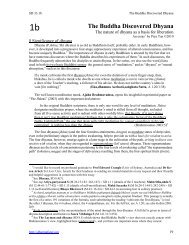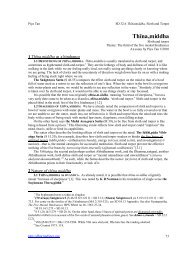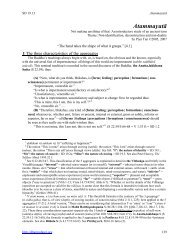40a.7-Nigantha-Natap.. - The Dharmafarers
40a.7-Nigantha-Natap.. - The Dharmafarers
40a.7-Nigantha-Natap.. - The Dharmafarers
You also want an ePaper? Increase the reach of your titles
YUMPU automatically turns print PDFs into web optimized ePapers that Google loves.
S 4.7.1.8 Sayutta Nikya 4, Saḷ,āyatana Vagga 7, Citta Saṁyutta 1, Citta Vagga 8<br />
7<br />
Nigaṇṭha Nāta,putta Sutta<br />
<strong>The</strong> Discourse on Nirgrantha Nāta,putta | S 41.8/4:298-300<br />
<strong>The</strong>me: Citta Gaha,pati does not go by faith and confounds Nāta,putta<br />
Translated by Piya Tan ©2007<br />
1 Citta the houselord‟s accomplishments<br />
1.1 CITTA AS DHARMA TEACHER. Citta is declared by the Buddha to be the foremost of Dharmaspeakers<br />
amongst the laymen disciples (A 1:26). 1 <strong>The</strong> native commentary on the Nigaṇṭha Nāta,putta Sutta<br />
(S 41.8) says that Citta the houselord approaches Nirgantha Nāta,putta, firstly to vindicate the Buddhists<br />
from being blamed that they do not show hospitality to anyone else. Citta shows every courtesy when<br />
he visits Nāta,putta, and warmly converses with him. Secondly, he approaches the Jains to refute their<br />
false views, at which time, says the Commentarty, he is already a non-returner (SA 3:100).<br />
Several times we see him teaching the Dhamma to bhikkhus, and the bhikkhus applaud him as one<br />
who has “the eye of wisdom that ranges over the deep Word of the Buddha.” <strong>The</strong> Citta Saṁyutta preserves<br />
three discourses of such instructions, that is, as follows:<br />
Saññojana Sutta the senses as fetters S 41.1/4:281-283 SD 32.11<br />
Kāma,bhū Sutta 1 the 3 roots as bondages S 41.5/4:291 f SD 71.9<br />
Go,datta Sutta the liberations of mind S 41.7/4:295-297 SD 60.4<br />
Even on his deathbed, Citta remains clearly mindful and instructing the Dharma to the devas, who are<br />
pleading with him to choose a rebirth that would conduce to their glory. <strong>The</strong> Gilāna Dassana Sutta (S<br />
41.10) records these remarkable final moments of Citta‟s life, especially how he admonishes the devas on<br />
the nature of impermanence. 2 All these positive accounts of Citta points to one clear fact—that he is the<br />
wisest of the Buddhist laymen.<br />
1.2 CITTA AS MEDITATOR. <strong>The</strong> Nigaṇṭha Nāta,putta Sutta depicts Nāta,putta as rejecting the idea of<br />
thought-free dhyanic experience [§§5-6]. Citta is clearly aware of this, and tries to point this out to the<br />
Jains. In answer to Nāta,putta‟s question on the possibility of thought-free dhyana [2.2], Citta answers:<br />
“Here, bhante, I do not go by faith in the Blessed One” [§§6.1-2].<br />
Before he can say anything further, Nāta,putta triumphantly declares that Citta “has no faith” in the<br />
Buddha! [§6.4]. Nāta,putta reads too much into Citta‟s reply, by going on to declare, using two similes<br />
that thought-free dhyanic meditation is impossible [§6.5-6]. This, in fact, puts Citta in a fix: he has been<br />
misquoted! If he were to remain silent, he would be acquiescing to Nāta,putta‟s false statement (which<br />
Nāta,putta is unaware of, too). 3<br />
<strong>The</strong> best way to deal with falsehood, especially concerning meditation, is the truth. However, before<br />
that Citta has to ensure that Nāta,putta is ready for the truth, even if he is unwilling or unable to accept it<br />
just yet. So Citta asks him which is “more sublime” (paṇīta,tara), faith or knowledge,and Nāta,putta answers<br />
that it is knowledge (ñāṇa) [§7]. Once this is established, Citta makes his lion-roar and defines his<br />
experience of the four dhyanas [§8].<br />
Nāta,putta is unimpressed; in fact, he is terribly confounded and upset, first at Citta‟s commitment to<br />
the Buddhist life, and secondly, at his own misjudgement of Citta. Hence, his outburst against Citta [§9].<br />
It is clear from this that Nāta,putta is not an accomplished meditator and has no experience of dhyana at<br />
all. At least, this is the Buddhist view of Nāta,putta.<br />
<strong>The</strong> Acela Kassapa Sutta 2 (S 41.9) records how Citta‟s old friend, Acela Kassapa has been a naked<br />
wanderer for 30 years, but failed to gain any spiritual attainment. In reply to Kassapa‟s question about his<br />
1 See Gilāna Dassana S (S 41.10/4:303 f), SD 16.16 (1). For his biography, see Nyanaponika & Hecker, Great<br />
Disciples of the Buddha, 1997:365-372.<br />
2 S 41.10/4:303 f = SD 16.16.<br />
3 This is a case where bad karma is still created when a person unmindfully makes a false statement. <strong>The</strong> intention<br />
here is rooted in delusion, and perhaps in greed and/or hate, too. See (Kamma,vāda) Bhūmija S (S 12.25/2:37-41),<br />
SD 31.2.<br />
http://dharmafarer.org 1
SD <strong>40a.7</strong><br />
S 41.8/4:198-300 • Nigaṇṭha Nātaputta Sutta<br />
own attainments, Citta replies that, he has spent 30 years in the spiritual life (as a Buddhist). On his part,<br />
he has not only been able to master the four dhyanas, but has also attained non-return. 4<br />
All these points clearly suggest to us an important point not so well known to many of us, especially<br />
those who are not well familiar with the suttas—that Citta the householder is perhaps the greatest of laymen<br />
meditators, more specifically, dhyana-attainers.<br />
2 Nirgrantha Nāta,putta in the early Buddhist texts<br />
2.1 JAINISM AND BUDDHISM. Of all the non-Buddhist religions mentioned in the early Buddhist<br />
texts, early Jainism appears to be closest to early Buddhism. 5 Both share many common terms (such as<br />
sutta, sīla, samādhi, āsava, arahata, nibbāna) and practices (the five precepts, the uposatha). One important<br />
difference is that while the Jains used what are loosely called “Jain Prakrits” (the chief of which was<br />
Ardha,māgadhī), the Buddha and the early Buddhists probably used a wide range of Prakrits, especially<br />
the local dialects. 6<br />
<strong>The</strong> key religious difference between the two systems is that early Buddhism unequivocally rejects<br />
any notion of an abiding soul (attā; Skt ātman), while Jainism holds the view of some kind of abiding<br />
entity (jīva). <strong>The</strong> early Buddhists are also less ritualistic, rejecting self-mortifying practices, while traditional<br />
Jains are strictly vegetarians and pro-life (such as wearing mouth-masks to avoid breathing in tiny<br />
living beings), but the stricter practitioners advocate ritual suicide (sallekhana). 7<br />
In the early Buddhist suttas, Nāta,putta is often presented as a tragic religious figure 8 who, amongst<br />
other things, loses three of his chief disciples—Upāli the houselord of Nālandā, Vappa the Sakya of Kapila,vatthu,<br />
and general Sīha of Vesālī—to the Buddhists. 9 Ironically, it is almost the Buddhists who seem<br />
to have led to Nāta,putta‟s tragic death, or to have indirectly cause it. After his chief disciple, general<br />
Upāli, converts to Buddhism, it is said that Nāta,putta, fell sick, coughed up blood and died as a result. 10<br />
2.2 NĀTA,PUTTA’S ENCOUNTER WITH CITTA<br />
2.2.1 Nāta,putta’s fatal question. <strong>The</strong> Nigaṇṭha Nāta,putta Sutta is a very brief text recounting Citta<br />
the houselords‟ meeting with the Jain leader, Nirgrantha Nāta,putta. Here, in the Nigaṇṭha Nāta,putta<br />
Sutta, he is presented as an undiscerning teacher who at once takes Citta at his word, without further questions.<br />
After the preliminaries niceties, Nāta,putta asks Citta if he (Citta) has faith in the Buddha that thought-free<br />
meditation is possible. This is actually two questions: (1) do you have faith in the Buddha (2)<br />
Do you really think thought-free meditation is possible<br />
Citta gives a careful but seemingly disarming answer to Nāta,putta‟s delight:<br />
“Here, bhante, I do not go by faith in the Blessed One, (when he says) thus, „<strong>The</strong>re is a samadhi<br />
without initial application and sustained application, there is a cessation of initial application<br />
and sustained application.‟” [§§6.1-2]<br />
2.2.2 Citta’s two verbal traps. In such a situation, the Buddha or a wise disciple would have further<br />
asked: “What do you mean by this” <strong>The</strong> undiscerning Nāta,putta, however, jumps to the hasty conclusion<br />
that the courteous Buddhist before him is a convert, even a turncoat. So he falls into a verbal trap; actually<br />
two traps, in which he is irretrievably caught.<br />
4 S 41.9/4:300-302 = SD 45.3. Cf Acela Kassapa S 1 (S 12.17/2:18-22), SD 18.5.<br />
5 On Jainism & Nāta,putta, see Upāli S (M 56) @ SD 27.1 (2.1).<br />
6 See esp Araṇa Vibhaṅga S (M 139.12/3:234 f), SD 7.8. Pali, however, is a literary language, used in the compilation<br />
of the only complete surviving collection of early Buddhist teachings. Both Ardha,magadhi and Pali are Prakrits<br />
(vernaculars) used as literary languages for their respective religious texts: see<br />
http://en.wikipedia.org/wiki/Jain_Prakrit.<br />
7 See Upāli S (M 56) @ SD 27.1 (2.1.2.1).<br />
8 Comy refers to him as “a naked, crooked and luckless nirgrantha” (nagga,bhoggaṁ nissirikaṁ nigaṇṭhaṁ, SA<br />
3:100).<br />
9 See Upāli S (M 56) @ SD 27.1 (2.3).<br />
10 Upāli S (M 56.31/1:387), SD 27.1.<br />
2<br />
http://dharmafarer.org
S 4.7.1.8 Sayutta Nikya 4, Saḷ,āyatana Vagga 7, Citta Saṁyutta 1, Citta Vagga 8<br />
This first statement by Citta is actually first of his verbal traps for the unwary Nāta,putta [§§6.1-2].<br />
While to Nāta,putta (mainly on account of wishful thinking), Citta seems to denounce the Buddha, what<br />
Citta is really saying is that his dhyanic experiences are attained through knowledge, not mere faith in the<br />
Buddha. On account of his personal experience, he has no need of relying on faith in the Buddha—he has<br />
direct knowledge (ñāṇa), based on personal experience. 11<br />
<strong>The</strong> second verbal trap that Citta lays for Nāta,putta, is when questions Nāta,putta, “What do you<br />
think, bhante, which is more sublime [more exquisite] (paṇīta,tara): knowledge (ñāṇa) or faith (saddhā)”<br />
[§7.1]. Nāta,putta, of course, replies that it is knowledge [§7.2]. <strong>The</strong> “three jewels‟ of the Jains,<br />
after all, are right view (samyak darśana, sometimes translated as “right faith”), right knowledge (samyak<br />
jñāna) and right conduct (samyak cāritra) (in an ascending order of priority). All this exchange occurs<br />
before the Jain congregation.<br />
2.2.3 Nāta,putta as dhyana-attainer. Citta then declares his deep familiarity (“to whatever extent I<br />
wish,” yāvad eva ākaṅkhāmi) with the four dhyanas [§8], ending with this important explanation:<br />
It is indeed not so, bhante! 12 Knowing thus, seeing thus (evaṁ jānanto evaṁ passanto), bhante,<br />
in what other recluse or brahmin need I go by faith that there is a samadhi without initial application<br />
and sustained application, a cessation of initial application and sustained application”<br />
[§8.5]<br />
Citta is saying that, having experienced dhyana all for himself, he has not need of faith in another, even in<br />
the Buddha himself. 13<br />
Nāta,putta is deeply dismayed and at once accuses Citta of dishonesty, trickery and falsehood [§9.3].<br />
Citta responds by simply stating the obvious—that Nāta,putta himself has presumed and misconstrued<br />
Citta‟s words and praising him, but now, knowing the truth, he is slighting him! <strong>The</strong>se are contradicting<br />
acts, rooted in contradicting mental states. Obviously, one of these reactions must be false! Indeed, this is<br />
sufficient to discredit a person in a public debate, and more significantly, as a spiritual teacher. It is now<br />
obvious that Nāta,putta is not an accomplished meditator, not even a mindful or perceptive teacher.<br />
2.2.4 <strong>The</strong> ten reasonable questions. <strong>The</strong> Nirgrantha Nāta,putta Sutta closes with Citta inviting Nāta,putta<br />
to a “Dharma-duel,” which clearly refers to the “ten reasonable questions” (saha,dhammika pañha)<br />
14 [§10.3], beginning with “what is „one‟,” “what is „two” and so on. <strong>The</strong>se questions seem to be a<br />
sort of a standard list for personal exchanges between two teachers or proponents of differing teachings,<br />
to present the essence of their wisdom (or lack thereof), so that the audience could see for themselves<br />
whose teachings are really true, good, useful and related to the spiritual goal.<br />
<strong>The</strong>se ten questions are phrased distributively in the plural, and comprise three parts, that is, the question<br />
(pañha) itself; the synopsis (uddesa) or brief statement; and the answer proper (vyākaraṇa), that is,<br />
the detailed explanation. Here is the case for the first question:<br />
(1) the question: “What is one”<br />
(2) the synopsis: “All beings are sustained by food”<br />
(3) the answer: “<strong>The</strong>re are these four kinds of food (āhāra), namely: material food, contact,<br />
volition and consciousness” (followed by detailed explanations). 15<br />
<strong>The</strong> way Citta has formulated the ten questions means, at least for the challenge he has thrown to the<br />
nirgranthas, can confound us at first: the questions are “numbered” in a cardinally distributive manner<br />
(that is, in terms of quantity), thus:<br />
11 Sāriputta uses the same pun, but in a clearer context (addressing the Buddha), in reference to his own<br />
attainment, in Pubba,koṭṭhaka S (S 48.44/5:220-222), SD 10.7.<br />
12 Meaning that Nāta,putta has misunderstood and misconstrued Citta‟s usage of the word “faith.”<br />
13 Two important points should be noted here: (1) Citta clearly has faith in the Buddha, but this is after the fact:<br />
this is “wise faith” (avecca-p,pāsāda): see Pañca Vera Bhaya S (S 12.41.11/2:69), SD 3.3(4.2); (2) Even the Buddha<br />
himself places the Dharma above himself: this is rightly putting the teaching before the teacher: see Gārava S<br />
(S 6.2/1:138-140), SD 12.3; see also <strong>The</strong> teacher or the teaching SD 3.14.<br />
14 On the meaning of saha,dhammika, see §10.3 n.<br />
15 See eg (Nīvaraṇa Bojjhaṅga) Āhāra S (S 46.51/5:102-107), SD 7.15.<br />
http://dharmafarer.org 3
SD <strong>40a.7</strong><br />
S 41.8/4:198-300 • Nigaṇṭha Nātaputta Sutta<br />
eko pañho eko uddeso ekaṁ veyyākaraṇaṁ,<br />
dve pañhā dve uddesā dve veyyākaraṇāni,<br />
tayo pañhā tayo uddesā tīṇī veyyākaraṇāni,<br />
cattāro pañhā cattāro uddesā cattārī veyyākaraṇāni,<br />
pañca pañhā pañca uddesā pañca veyyākaraṇāni,<br />
cha pañhā cha uddesā cha veyyākaraṇāni,<br />
satta pañhā satta uddesā satta veyyākaraṇāni,<br />
aṭṭha pañhā aṭṭha uddesā aṭṭha veyyākaraṇāni,<br />
nava pañhā nava uddesā nava veyyākaraṇāni,<br />
dasa pañhā dasa uddesā dasa veyyākaraṇānîti. [§10.3]<br />
It would have been easier for us if Citta had used the more conventional ordinal listing of the questions as<br />
paṭhamo pañho (“the first question”), dutiyo pañho (“the second question”), tatiyo pañho (“the third<br />
question”), and so on. This is, in fact, the usual way these questions are listed. But Citta is no ordinary<br />
layman: he is the wisest of them, and one with (one might say) a transcendental sense of humour! 16<br />
We could read what Citta is trying to impress on the nirgranthas thus: “First, there is the question on<br />
„one.‟ <strong>The</strong>n, when that is completed, we have the second question, which makes it two question...and finally,<br />
we have ten questions.” In the minds of the ignorant, the half-informed or half-baked, even one such<br />
question can be daunting. What more ten! And from such a “devious” Buddhist such as Citta!<br />
Traditionally, here Citta has invited Nāta,putta and the nirgranthas to give a “reasonable” response to<br />
these questions. Nirgrantha Nāta,putta is, however, either unwilling or unable to do so; hence, Citta, having<br />
no further reason to stay on, leaves [§10.4]. 17<br />
2.2.4 <strong>The</strong> boy’s questions. <strong>The</strong> ten questions are preserved as “the boy‟s questions” (kumāra,pañha)<br />
in the Khuddaka,pāṭha (Khp 4) 18 and known as “the great questions” (mahā pañha) in the Mahā Pañha<br />
Sutta 1 (A 10.27), where they are explained in some detail. 19 Within each set, the question arises for each<br />
number, the synopsis given, and the practitioner is to reflect on its details by way of spiritual training.<br />
Why are these ten questions called “the boy‟s questions” <strong>The</strong> explanation is given in the Param’attha,jotikā<br />
(the Khuddaka Pātha Commentary), where it is said that it has to do with the ordination (upasampadā)<br />
of the 7-year-old arhat, Sopaka. On his attaining of direct knowledge (aññā), the Buddha decides,<br />
on account of his attainment, he should be able to answer these questions, which would also be his<br />
mode of ordination (KhpA 75 f).<br />
Interestingly, the word “boy” (kumāra) here reminds us of “brahmin youth” (māṇava), a term for a<br />
young brahmin student who is accomplished in the three Vedas. A young houselord, one who is heir to<br />
his father‟s estate is called “young houselord” (gaha.pati,putta). 20 <strong>The</strong>se two terms, however, are never<br />
used for Buddhist renunciants. However, erstwhile members of the kshatriya (noble) class who have renounced<br />
are often referred to as “sons of family” (kula,putta). 21 However, the term kumāra seems to be<br />
applied only to the ten questions.<br />
— — —<br />
16 On humour in Buddhism, see <strong>The</strong> Buddha’s humour = SD 50.1.<br />
17 On the possible consequence that the questioner might face (head-splitting) for not answering such a question,<br />
see Ambaṭṭha S (D 3.1.21.1/1:95) + SD 21.3 (4).<br />
18 Khp 4/2, explained in KhpA 75-88.<br />
19 A 10.27/5:50-54 = SD 85.15.<br />
20 On gaha.pati,putta, see Sigāl’ovāda S (D 31.1.2/3:180) n = SD 4.1.<br />
21 V 1:15,1 (Yasa), 350,34 (3 of them); D 1:93,20 (Ambaṭṭha māṇava is said to be kula,putta, too); M 1:192,5; A<br />
2:249,11. In Vakkali S (S 22.87.39/3:124), SD 8.8, the Buddha refers to Vakkali posthumously as kula,putta instead<br />
of bhikkhu. Vakkali was prob in his early 20s. <strong>The</strong> aged Pukkusti is similarly referred to as kula,putta in Dhtu<br />
Vibhaga S (M 140), SD 4.17.3n. See also Mahā,parinibbāna S (D 16.5.8ab), SD 9(7g).<br />
4<br />
http://dharmafarer.org
S 4.7.1.8 Sayutta Nikya 4, Saḷ,āyatana Vagga 7, Citta Saṁyutta 1, Citta Vagga 8<br />
<strong>The</strong> Discourse on Nigaṇṭha Nāta,putta<br />
S 41.8/4:298-300<br />
Citta meets Nāta,putta<br />
2 Now at that time, Nirgrantha Nāta,putta 22 [298] had arrived in Macchikā,saṇḍa 23 with a great<br />
company of nirgranthas [Jain monks].<br />
3 Citta the houselord 24 heard that Nirgrantha Nāta,putta had arrived in Macchikā,saṇḍa with a great<br />
company of nirgranthas.<br />
4 <strong>The</strong>n Citta the houselord, along with some laymen followers, approached Nirgrantha Nāta,putta,<br />
exchanged courteous and friendly greetings, and then sat down at one side.<br />
5.1 Nirgrantha Nāta,putta said this to Citta the houselord, sitting thus at one side:<br />
“Do you, houselord, have faith in the recluse Gotama when he says,<br />
5.2 „<strong>The</strong>re is a samadhi without initial application and sustained application [thinking and pondering];<br />
there is a cessation of initial application and sustained application‟” 25<br />
Citta tricks Nāta,putta<br />
6.1 “Here, bhante, I do not go by faith in the Blessed One, 26 (when I say) thus,<br />
6.2 „<strong>The</strong>re is a samadhi without initial application and sustained application, there is a cessation of<br />
initial application and sustained application.‟”<br />
6.3 When this was said, Nigaṇṭha Nāta,putta looked around 27 at his own retinue, and said,<br />
6.4 “See this, sirs! How straight is this Citta the houselord! How honest [not dishonest] is this Citta<br />
the houselord! How untricky [not a trickster] is this Citta the houselord!<br />
6.5 One who thinks that initial application [thinking] can be stopped would imagine that he could<br />
catch the wind in a net,<br />
6.6 one who thinks that sustained application [pondering] can be stopped would imagine that he<br />
could stop the flow of the river Ganges with his own fist.”<br />
7.1 “What do you think, bhante, which is more sublime [more exquisite]: knowledge or faith”<br />
7.2 “Surely, houselord, knowledge is more sublime than faith.” 28<br />
Citta‟s lion-roar<br />
8.1 29 Now I, bhante, to whatever extent I wish,<br />
22 He was Mahā,vīra (b 549-477 BCE), 22 the historical founder of Jainism: see Upāli S (M 56) @ SD 27.1 (2.1).<br />
23 Macchika,saṇḍa, lit “fishers‟ clump,” a grove belonging to Citta, and a town in Kāsī, 30 yojanas from Sāvatthī<br />
(DhA 2:79), the home of Citta the houselord. Located there is Ambāṭaka,vana (wild mango park) presented by Citta<br />
as a monastery to the monks headed by Mahānāma. From this Sutta, it is possible that Macchika,saṇḍa was one of<br />
the centres of the nirgranthas.<br />
24 Citta is declared by the Buddha to be the foremost of Dharma-speakers amongst the laymen disciples (A 1:26):<br />
see Gilāna Dassana S (S 41.10/4:303 f), SD 16.16 (1).<br />
25 As will be apparent soon, this clearly refers to the 2 nd dhyana.<br />
26 Na khv-āhaṁ ettha bhante bhagavato saddhāya gacchāmi.<br />
27 “Looked around,” Be Ee SA:Be ulloketvā, “having looked up at”; Ke Se SA:Ce SA:Se oloketvā, “having looked<br />
down at (with regard)”; Se apaloketvā, “having looked towards” (Cf Mahā,parinibbāna S (D 16.4.1/2:122 n), SD<br />
9). Comy: “Ulloketvā: Puffing up his body, drawing in his belly, craning forth his neck, looking all around, he then<br />
looked up” (ulloketvâti kāyaṁ unnāmetvā kucchiṁ nīharitvā gīvaṁ paggayha sabbaṁ disaṁ pekkhamāno ulloketvā,<br />
SA 1:300). <strong>The</strong> context suggests a sense of overconfidence and pride on Nāta,putta‟s part; hence. He “looks around”<br />
at his congregation for acquiescence. Cf §9.2.<br />
28<br />
Saddhāya kho gaha,pati ñāṇaṁ y’eva paṇīta,taraṁ. See Intro (1.2).<br />
29 Ahaṁ kho bhante yāvad eva ākaṅkhāmi vivicc’eva kāmehi vivicca akusalehi dhammehi sa,vitakkaṁ sa,vicāraṁ<br />
viveka,jaṁ pīti,sukhaṁ paṭhamaṁ jhānaṁ upasampajja viharāmi. On the 1 st dhyana, see Dhyana @ SD 8.4 (5.1) or<br />
SID: jhāna 4.<br />
http://dharmafarer.org 5
SD <strong>40a.7</strong><br />
S 41.8/4:198-300 • Nigaṇṭha Nātaputta Sutta<br />
having entered, dwell in the first dhyana, that is quite detached from sensual pleasures, detached<br />
from unwholesome mental states, accompanied by initial application and sustained application, accompanied<br />
by zest and joy, born of seclusion; [299]<br />
8.2 30 And I, too, bhante, to whatever extent I wish,<br />
with the stilling of initial application and sustained application, by gaining inner tranquillity and oneness<br />
of mind, having entered, dwell in the second dhyana, free from initial application and sustained<br />
application, accompanied by zest and joy born of concentration.<br />
8.3 31 And I, too, bhante, to whatever extent I wish,<br />
with the fading away of zest, I, having entered, dwell equanimous, mindful and fully aware, and experiences<br />
joy with the body. Having entered, I dwell in the third dhyana, of which the noble ones declare,<br />
„Happily he dwells in equanimity and mindfulness.‟<br />
8.4 32 And I, too, bhante, to whatever extent I wish,<br />
with the abandoning of joy and abandoning of pain—and with the earlier disappearance of pleasure<br />
and displeasure—having entered, dwell in the fourth dhyana that is neither painful nor pleasant, and<br />
with mindfulness fully purified by equanimity. 33<br />
8.5 It is indeed not so, bhante! Knowing thus, seeing thus, bhante, in what other recluse or brahmin<br />
need I go by faith that there is a samadhi without initial application and sustained application, a cessation<br />
of initial application and sustained application” 34<br />
Nāta,putta is outwitted<br />
9.2 When this was said, Nirgrantha Nāta,putta turned around 35 and said this to his own congregation:<br />
9.3 “See this, sirs! How crooked is this Citta the houselord! How dishonest is this Citta the houselord!<br />
How tricky is this Citta the houselord!”<br />
9.4 “But, bhante, only just now we understand you as saying:<br />
„See this, sirs! How straight is this Citta the houselord! How honest [not dishonest] is this Citta the<br />
houselord! How untricky [not tricky] is this Citta the houselord!‟<br />
9.5 But now we understand you as saying:<br />
„See this, sirs! How crooked is this Citta the houselord! How dishonest is this Citta the houselord!<br />
How tricky is this Citta the houselord!‟<br />
10.1 If, bhante, your former statement is true, your later statement must be false! If, bhante, your<br />
later statement is true, your former statement must be false!<br />
30 Ahaṁ kho bhante yāvad eva ākaṅkhāmi vitakka,vicārānaṁ vūpasamā ajjhattaṁ sampasādanaṁ cetaso ekodi,-<br />
bhāvaṁ avitakkaṁ avicāraṁ samādhi,jaṁ pīti,sukhaṁ dutiyaṁ jhānaṁ upasampajja viharāmi. On the 2 nd dhyana,<br />
see Dhyana @ SD 8.4 (5.2) or SID: jhāna 4.<br />
31 Ahaṁ kho bhante yāvad eva ākaṅkhāmi pītiyā ca virāgā ca upekkhako ca viharati sato ca sampajāno, sukhañ<br />
ca kāyena paṭisaṁvedeti. Yaṁ taṁ ariyā ācikkhanti: upekkhako satimā sukha,vihārîti, tatiyaṁ jhānaṁ upasampajja<br />
viharāmi. On the 3 rd dhyana, see Dhyana @ SD 8.4 (5.3) or SID: jhāna 4.<br />
32 Ahaṁ kho bhante yāvad eva ākaṅkhāmi sukhassa ca pahāṇā dukkhassa ca pahāṇā pubb’eva somanassa,domanassānaṁ<br />
atthaṅ,gamā adukkhaṁ asukhaṁ upekkhā,sati,parisuddhiṁ catutthaṁ jhānaṁ upasampajja viharāmi. On<br />
the 4 th dhyana, see Dhyana @ SD 8.4 (5.4) or SID: jhāna 4.<br />
33 Similarly, to his old friend, Acela Kassapa, a naked wanderer for 30 fruitless years, he speaks of the 4 dhyanas:<br />
Acela Kassapa S 2 (S 41.9/4:300-302), SD 45.3. Cf Acela Kassapa S 1 (S 12.17/2:18-22), SD 18.5.<br />
34 Na so khvâhaṁ bhante evaṁ jānanto evaṁ passanto kassa aññassa samaṇassa vā brāhmaṇassa vā saddhāya<br />
gamissāmi “atthi avitakko avicāro samādhi atthi vitakka,vicārānaṁ nirodhôti. Here, Nāta,putta has fallen into both<br />
of Citta‟s verbal traps [2.2]. On account of Citta‟s personal experience, he has no need of relying on faith in the<br />
Buddha. Sāriputta uses the same pun, in reference to his own attainment, in Pubba,koṭṭhaka S (S 48.44/5:220-222),<br />
SD 10.7.<br />
35 “Looked around,” Be Ee Ke Se apaloketvā; Ce ulloketvā. Here apaloketvā (the most common reading), with a<br />
sense of “looking for approval” (CPD), ie, looking embarrassed or angry at being betrayed or exposed, fits the context<br />
best. Understandably, he loudly complains to his congregation, again seeking their support. Cf §6.3.<br />
6<br />
http://dharmafarer.org
S 4.7.1.8 Sayutta Nikya 4, Saḷ,āyatana Vagga 7, Citta Saṁyutta 1, Citta Vagga 8<br />
Citta challenges Nāta,putta<br />
10.2 Now, bhante, we come to these ten reasonable questions. 36<br />
10.3 As you understand their meaning, let you and the company of nirgranthas so respond to me: 37<br />
one question, one synopsis, one answer; 38<br />
two questions, two synopses, two answers; 39<br />
three questions, three synopses, three answers;<br />
four questions, four synopses, four answers;<br />
five questions, five synopses, five answers;<br />
six questions, six synopses, six answers;<br />
seven questions, seven synopses, seven answers;<br />
eight questions, [300] eight synopses, eight answers;<br />
nine questions, nine synopses, nine answers;<br />
ten questions, ten synopses, ten answers.”<br />
10.4 <strong>The</strong>n, Citta the houselord, not getting any answer from Nirgrantha Nāya,putta, 40 rose from his<br />
seat and left.<br />
— evaṁ —<br />
071128; 121002; 121004; 130302<br />
36 Ime kho pana bhante dasa saha,dhammikā pañhā āgacchanti. Comy glosses saha,dhammika as “reasonable”<br />
(sa,kāraṇā, SA 3:100): cf Ambaṭṭha S (D 3.1.20/1:94 = SD 21.3),where Comy explains that “even if one oneself<br />
does not desire to answer, it is must necessarily be clarified” (DA 1:263).<br />
37 Yadā tesaṁ atthaṁ ājāneyyāsi atha maṁ paṭihareyyāsi saddhiṁ nigaṇṭha parisāya. Comy gives a fanciful explanation<br />
(see S:B 1446 n323) which need not detain us. In Deva,daha S (M 101), we find two occurrences of the<br />
helpful phrase, saha,dhammikaṁ vāda,paṭihāraṁ, “a reasonable defence of one‟s doctrine” (M 2:218,22, 220,8),<br />
which Comy glosses as follows: “saha,dhammika means with cause, with reason; vāda,pātihāra means „return<br />
speech‟” (saha,dhammikaṁ sa,hetukaṁ sa,kāraṇaṁ; vāda,paṭihāran ti paccāgamanaka,vādaṁ, MA 4:4). We can<br />
easily surmise here (what Citta is saying) is that Nāta,putta and the nirgranthas are invited to give a “reasonable” response<br />
to these questions (if they could). Nirgrantha Nāta,putta is either unwilling or unable to do so; hence, Citta,<br />
having no further reason to stay on, leaves [§10.4]. See Intro (2.2.4).<br />
38 Eko pañho eko uddeso ekaṁ veyyākaraṇaṁ. Comy says that these are “the boy‟s questions” (kumāra,pañha):<br />
see Khp 4/2 = D 3:211; KhpA 75-78; PmA 1:65, 67. <strong>The</strong> 10 questions here are actually found in Mahā Pañha S 1<br />
(A 10.27) where they are fully listed and explained (A 10.27/5:50-54), SD 85.15.<br />
39 Dve pañhā dve uddesā dve veyyākaraṇāni. Although the questions here are phrased distributively in the plural,<br />
from Mahā Pañha S 1 (A 10.27, see prec n), it is clear that they refer to the respective “sets” as in the Kumāra,pañha.<br />
Within each set, the question arises for each of the items, on which the practitioner is to reflect by way of spiritual<br />
training: see A 10.27/5:50-54 = SD 85.15. See Intro (2.2.4).<br />
40 Na khv-āhaṁ ettha bhante bhagavato saddhāya gacchāmi.<br />
http://dharmafarer.org 7


